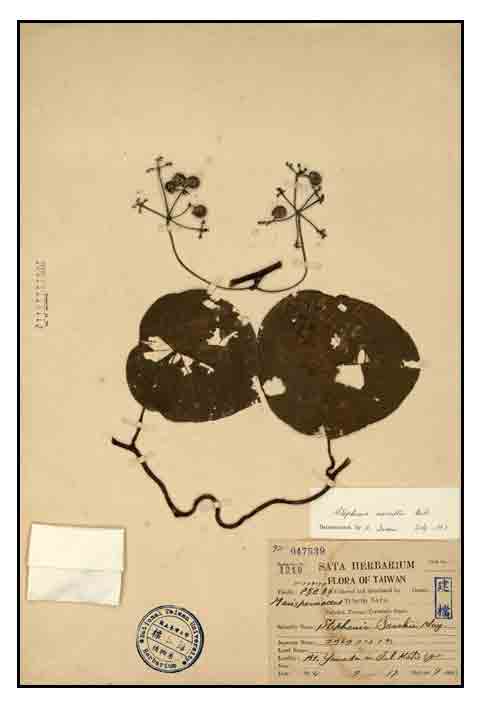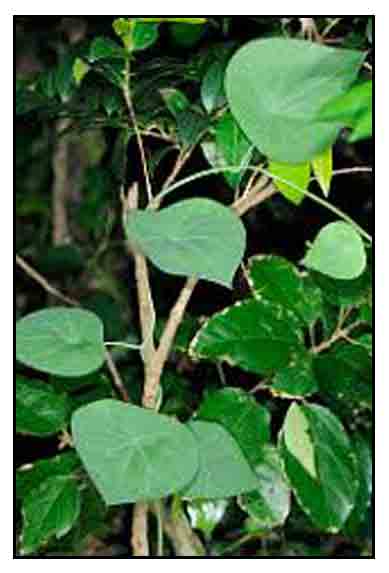 Botany Botany
Stephania sasakii is a vigorous, woody vine. Branches are about 1 centimeter in diameter, with 10 ridges. Smooth leaves are broadly ovate or somewhat rounded, 9 to 12 centimeters long, 8.5 to 11 centimeters wide; the apex short, mucronate, and pointed, the base rounded and peltate, on petioles as long as the leaves; the margins entire and minutely revolute. Fruiting branches are peduncle3d, 8 to 12 centimeters long, and borne in the axils of the leaves. Fruit is obovate, about 1.2 centimeters long, and 1 centimeter wide, and 4 millimeters thick.
Additional taxon info
Stephania sasakii was originally reported from Kotosho Island, southeast of Taiwan. A specimen of Stephania collected on Batan Islands, Batanes was identified as S. sasakii. It is considered to differ from its common allied species Stephania merrillii in size of the leaves, which are broader and rounder, and differs also in its larger fruit, and other floral characteristics of the sepals and petals.
Distribution
- Originally identified in Taiwan.
- Also reported in Batan Islands, Batanes.
Constituents
 - Species of Stephania are of interest chemically and therapeutically. - Species of Stephania are of interest chemically and therapeutically.
- Stephania cepharantha Hayata in Takao, Taiwan, yielded an alkaloid, cepharantin, which was studied and used in Japan as a cure for tuberculosis.
- Studies have reported the presence of cepharantin in S. sasakii in Taiwan.
-
There are no studies that confirm its presence in Philippine species of Stephania in Luzon: S. Merrillii, S. ramosii, and S. catosepala. None of these three species have the stout and tuberous roots of S. cepharantha, but the stems may contain the alkaloid, cepharantin, isolated from S. sasakii.
- Stephania sasakii yielded alkaloids obaberine, thairugosine, aknadinine, secocepharanthine and O-methylpunjabine. (Moza et a., 1970; Kunitomo, 1985) (4)
- Two new secobisbenzylisoquinoline alkaloids, secocepharanthine (3) and O-methylpunjabine (4). Their structures were established, along with two other alkaloids, dihydrosecocepharanthine (1) and O-methyldeoxopunjabine (2). In addition, two known bisbenzylisoquinoline alkaloids, obaberine (5) and thalrugosine (6) were newly isolated from the same plant. (7)
Uses
Folkloric
- No reported folkloric medicinal use in the Philippines.
- In Japan, cepharantin alkaloid has been studies and used in the treatment and prevention of tuberculosis.
Studies
• Alkaloids: 1980 study isolated five new alkaloids, dehydrocrebanine, 4,5-dioxodehydrocrebanine, stesakine, dehydrostesakine, bisaknadinine and four known alkaloids, lirodenine, lanuginosine, 1-tetrahydropalmatine, d-isocorydine with a few alkaloids of unknown structure.
•
Two Unknown Alkaloids: The structures of two unknown alkaloids from Stephania sasakii Hayata were established as 4-hydroxycrebanine (1), a new 4-hydroxyaporphine alkaloid, and (R)--roemeroline (3), respectively. (6)
Availability
Wild-crafted.
|

![]()





